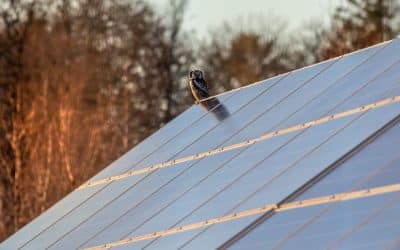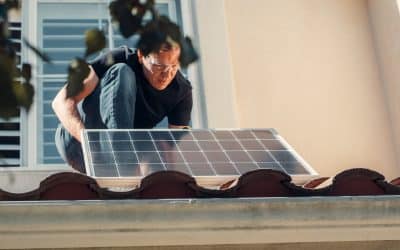How Long Does It Take for Ring Solar Panel to Charge?
How long does it take for a Ring solar panel to charge? This is a common question among those considering investing in this innovative, eco-friendly solution for powering their Ring devices. Understanding the charging time of a Ring solar panel is crucial for optimal usage and convenience. This blog post will delve into the factors influencing the charging duration and provide the necessary information to make an informed decision. So, let’s explore the intricacies of how long it takes for a Ring solar panel to charge.
Key Takeaways
- The charging time of Ring Solar Panel varies based on several factors.
- The average charging time for Ring Solar Panel is around 5-10 hours.
- The amount of sunlight available can affect the charging time.
- Ring Solar Panel charges faster in direct sunlight than cloudy or shaded conditions.
- It is recommended to place the Ring Solar Panel in an area with maximum sunlight exposure for optimal charging.
- The capacity and efficiency of the connected Ring device also impact the charging time.
- Ring Solar Panel is designed to provide a continuous charge to the connected Ring device.
- The charging time may vary depending on the specific model of the Ring Solar Panel.
- Regular solar panel maintenance and cleaning can help maximise its charging efficiency.
- You should be able to refer to the product manual or contact Ring customer support for detailed information on charging times specific to your Ring Solar Panel model.
What is a Ring Solar Panel?
A Ring Solar Panel is a reliable, eco-friendly charging solution that keeps specific Ring devices powered up through consistent trickle charging.
Designed to harness the sun’s energy, this panel significantly reduces the need for manual recharges. It is compatible with devices such as the Stick Up Cam and Spotlight Cam Battery, providing a sustainable power source for extended battery life.
The installation process is simple and can be done without professional assistance. With its durable and weather-resistant construction, the Ring Solar Panel is optimised for optimal placement in direct sunlight.
Its compact design seamlessly integrates into outdoor environments, making it an efficient auxiliary power source for Ring devices.
Importance of Understanding Charging Time
Understanding charging time is crucial for battery health, ensuring optimal device performance and longevity.
It aids in time management, preventing unexpected device downtimes. Awareness of charging duration promotes safety, reducing overcharging or battery damage risks.
Efficient charging can save energy and reduce costs while minimising environmental impact.
Informed charging habits influence purchasing decisions and balance reliance on quick charges, safeguarding battery life.
Efficient use of electronic devices.
By clearly understanding the charging time, users can plan their device usage accordingly and avoid unnecessary interruptions.
Knowing how long it takes for a device to charge fully allows users to optimise their productivity, ensuring that their electronic devices are ready when needed.
Additionally, understanding charging time helps users make informed decisions about battery life and usage patterns, promoting better battery health and longevity.
Moreover, being aware of charging times can help users save energy and reduce their carbon footprint by optimising charging cycles and avoiding overcharging.
A comprehensive understanding of charging time is essential for maximising the efficiency and longevity of electronic devices.
Inconvenience and delays in device usage.
Longer charging times can significantly impact the convenience and efficiency of device usage.
When devices take longer to charge, users are often inconvenienced by waiting for extended periods before they can utilise them. This can result in delays in completing essential tasks or accessing necessary information, affecting productivity.
Also, longer charging times may disrupt daily routines and schedules, causing frustration and hindering progress.
Furthermore, longer charging times can pose potential risks and complications when devices are relied upon for communication or emergency purposes.
Therefore, addressing and minimising charging time requirements is crucial to ensure optimal device usage and user satisfaction.
Extend the lifespan of batteries.
Efficient charging plays a crucial role in prolonging the lifespan of batteries.
The amount of stress and strain placed on the battery cells minimises by ensuring that batteries are charged optimally.
This, in turn, helps to reduce the accumulation of degradation factors such as heat and overcharging, which can significantly impact battery health.
Furthermore, efficient charging techniques help maintain the battery’s capacity and prevent capacity degradation over time.
Additionally, by utilising charging methods specifically tailored to the battery type and manufacturer’s recommendations, users can maximise the overall longevity of their batteries.
Prioritising efficient charging practices is essential for extending the lifespan of batteries and maximising their performance.
Better planning and scheduling
Knowing the charging time of your ring solar panel allows for better planning and scheduling.
Individuals can allocate their time more effectively by understanding how long it takes for a particular device to charge fully.
This knowledge enables them to plan and ensure that devices are charged and ready when needed.
Additionally, it allows for efficient scheduling of tasks and activities, as individuals can factor in the charging time required for their devices.
Being aware of the charging time also helps prevent situations where devices run out of battery unexpectedly, avoiding interruptions and delays.
This information ultimately empowers individuals to optimise their time management and productivity.
Sunlight intensity and panel capacity
Several factors, including sunlight intensity and panel capacity, influence Ring solar panels’ charging time.
A ring solar panel need direct sunlight exposure. The amount of sunlight directly affects the charging speed, as panels require sufficient sunlight to convert it into electrical energy.
Higher sunlight intensity leads to faster charging times, while lower intensity may result in longer charging durations.
Additionally, the panel capacity plays a crucial role, as panels with higher capacity can harness more solar energy and charge more efficiently.
Therefore, it is essential to consider both sunlight intensity and panel capacity when estimating the charging time of Ring solar panels.
Ensure continuous power supply for security devices.
It is crucial to consider the charging time of Ring solar panels when aiming for an uninterrupted power supply for security devices.
The charging time directly affects the availability of energy, which is essential for the functioning of these devices.
By considering the charging time, users can ensure that the solar panels have enough exposure to sunlight to generate sufficient power.
This, in turn, guarantees that the security devices powered by these panels can operate continuously without any interruptions or downtime.
Therefore, evaluating the charging time of Ring solar panels becomes a fundamental aspect of maintaining a consistent and reliable power source for security devices.
Optimise their performance and reliability.
Understanding the charging time of Ring solar panels is crucial for optimising their performance and reliability.
By knowing how long it takes for the panels to charge fully, users can effectively plan their energy usage and ensure a consistent power supply.
This knowledge allows for better management of devices connected to the solar panels, preventing any potential power shortages or interruptions.
Furthermore, understanding the charging time helps users gauge the panels’ efficiency and identify potential hindering issues——their romance.
By optimising the charging time, users can maximise the benefits of Ring solar panels and rely on them for a reliable and sustainable power source.
Make informed decisions about their energy needs
Knowing the charging time of Ring solar panels is crucial for users to make informed decisions about their energy needs.
Users can effectively plan their energy consumption and optimise their usage by understanding the time it takes for the panels to charge fully.
This information allows users to determine how many panels they need to meet their desired energy requirements and whether additional backup power sources are necessary.
Additionally, being aware of the charging time enables users to plan for any potential power outages or periods of limited sunlight, ensuring a continuous and uninterrupted power supply.
Ultimately, knowing about the charging time of Ring solar panels empowers users to make informed and efficient choices regarding their energy consumption.
Maximise their energy efficiency and reduce reliance on traditional power sources.
Understanding the charging time of Ring solar panels allows users to make informed decisions that enhance energy efficiency and decrease dependence on conventional power sources.
By knowing how long it takes for the panels to charge, users can schedule their power usage effectively, ensuring they make the most of the available solar energy.
This knowledge empowers users to optimise their energy consumption patterns, minimising waste and utilising clean, renewable energy.
Users can contribute to a more sustainable and environmentally friendly energy ecosystem by reducing reliance on traditional power sources.
Factors Affecting Charging Time
Sunlight intensity
The intensity of sunlight directly influences the charging time of a Ring solar panel it receives.
Sunlight intensity is crucial in determining how efficiently the solar panel can convert solar energy into electrical energy. When the sunlight is intense, the solar panel can capture and convert more energy, resulting in faster charging times.
Conversely, when the sunlight intensity is lower, the solar panel’s energy conversion efficiency decreases, leading to longer charging times. Therefore, it is essential to ensure that the solar panel is positioned in an area with ample sunlight intensity to optimise its charging capabilities.
Weather conditions
Cloudy or overcast weather can significantly impact the charging time of solar panels. When the sky clouds obscure, the sunlight reaching the solar panel is reduced.
This reduction in sunlight intensity directly affects the solar panel’s energy conversion process efficiency. Consequently, the charging time of the solar panel may be prolonged, as the panel generates less electricity in such weather conditions.
It is essential to consider the weather forecast when relying on solar power, as the availability of sunlight directly affects the performance of solar panels.
Panel orientation
The angle at which the panel is positioned about the sun directly affects the sunlight it receives throughout the day. For optimal performance, solar panels are usually tilted at an angle that allows them to capture the maximum amount of sunlight.
Additionally, the direction in which the panel faces is equally essential. Orienting the solar panel towards the south in the northern hemisphere or the north in the southern hemisphere ensures that it receives sunlight for a longer duration, maximising its charging potential.
Therefore, carefully considering panel orientation is essential to maximise the charging efficiency of solar panels.
Panel cleanliness
Dust, dirt, or debris on the solar panel’s surface can significantly impact its performance and efficiency. When the panel is covered in such particles, they act as barriers that obstruct the sunlight from reaching the solar cells.
As a result, the panel’s ability to capture sunlight and convert it into usable energy is compromised. This reduction in sunlight absorption can lead to a prolonged charging time as the panel’s output decreases.
Therefore, maintaining panel cleanliness is essential to ensure optimal solar energy generation and maximise the panel’s efficiency.
Battery capacity
The size and capacity of the battery connected to the solar panel play a crucial role in determining the overall charging time. A larger battery with a higher capacity can store more energy from the solar panel, allowing for a longer and more efficient charging process.
On the other hand, a smaller battery with limited capacity may require frequent recharging and result in longer charging times. Considering the battery capacity when setting up a solar panel system is essential
to ensure optimal charging efficiency and uninterrupted power supply. By choosing a battery with an appropriate size and capacity, users can maximise the benefits of solar energy and minimise any potential charging delays.
Power consumption
The power consumption of devices connected to a solar panel significantly determinesmore the charging time. The more power these devices consume, the longer it takes for the solar panel to generate and supply the required energy.
High power consumption can lead to a slower charging process, as the solar panel needs to produce a larger amount of energy to meet the demand. On the other hand, devices with lower power consumption can be charged more quickly as they require less energy from the solar panel.
Therefore, it is essential to consider device power consumption when using solar panels for charging purposes.
Cable length and quality
The length and quality of the cable connecting the solar panel to the device significantly affect the charging speed. A longer cable introduces more resistance, leading to a drop in voltage along the cable’s length and, subsequently, slower charging.
Poor-quality cables with insufficient insulation can further increase resistance, resulting in slower charging rates. It is essential to use cables with appropriate gauge and highgaugesity materials to minimise resistance and maximise the charging efficiency.
By ensuring the optimal length and quality of the cable, users can enhance the charging speed and overall performance of their solar-powered devices.
Battery health
Battery health refers to the condition and age of a battery, which can significantly impact its ability to charge efficiently.
When a battery is in good condition, it can store and release energy effectively, leading to optimal charging performance. However, as the battery ages, its capacity and overall health may deteriorate, reducing charging efficiency.
Factors like temperature, usage patterns, and charging habits influence battery health. Therefore, monitoring and maintaining battery health is crucial to ensure optimal charging performance and prolong the battery’s lifespan s, which significantly increases impact.
Ambient temperature
Extreme temperatures, whether excessively hot or cold, can have a significant impact on the charging performance of solar panels.
In high temperatures, the efficiency of solar panels can decrease due to increased resistance in the electrical circuit. This can lead to a reduction in the overall power output of the solar panel system.
Conversely, in frigid temperatures, solar panels may experience a decrease in performance as the chemical reactions within the photovoltaic cells slow down.
These variations in ambient temperature can thus influence the charging capabilities of solar panels, highlighting the importance of considering temperature factors when assessing and optimising the efficiency of solar energy systems.
Solar panel efficiency
The overall efficiency of a solar panel directly impacts its charging time. Solar panel efficiency refers to how effectively the panel converts sunlight into usable electricity.
Higher-efficiency panels can convert a more significant percentage of sunlight into electricity, resulting in faster charging times. In contrast, lower-efficiency panels may take longer to charge due to their reduced ability to convert sunlight into usable energy.
Therefore, when selecting a solar panel, it is essential to consider its efficiency as it directly affects the charging time and overall system performance.
Understanding the Role of Ring Solar Panel
The Ring Solar Panel is crucial in powering Ring devices, providing a sustainable and eco-friendly charging solution. It is an essential accessory for Ring devices, such as Ring Video Doorbells and Spotlight Cams.
It harnesses solar energy to charge the device’s battery, eliminating the need for frequent manual recharging or reliance on traditional power sources.
Auxiliary Power Source
The Ring Solar Panel is crucial as an auxiliary power source for various Ring devices, providing an efficient and sustainable solution for powering security systems.
Harnessing the power of the conservative panel offers a reliable and environmentally friendlyis vital alternative to traditional electrical outlets. Its primary function lies in charging the batteries of Ring devices, enabling them to operate seamlessly and continuously.
Additionally, the Ring Solar Panel eliminates the need for frequent battery replacements, reducing maintenance costs and ensuring uninterrupted surveillance.
With its ability to convert sunlight into a reliable power source, the Ring Solar Panel plays a vital role in enhancing the overall efficiency and performance of Ring security systems.
Supplementing Primary Power Sources
Ring Solar Panel plays a crucial role in supplementing primary power sources. By harnessing solar energy, it provides an additional and sustainable power supply to support the primary power sources.
This supplementary power source ensures uninterrupted operation and functionality of connected devices and systems. Moreover, the Ring Solar Panel reduces reliance on traditional grid electricity, contributing to energy efficiency and cost savings.
With its ability to convert sunlight into usable power, the Ring Solar Panel is an effective solution for enhancing the overall reliability and resilience of primary power sources.
Conclusion
In conclusion, the charging time of the Ring Solar Panel is an important additionfriendly for those looking to maximise the efficiency of their Ring devices.
While the exact time may vary depending on factors such as sunlight intensity and panel placement, it typically takes 5 to 10 hours to fully charge the Ring Solar Panel.
This information is crucial for users who rely on solar power as a sustainable and cost-effective solution for powering their Ring devices. By understanding the charging time, users can plan their device usage accordingly and ensure uninterrupted security and convenience.
As the demand for eco-friendly energy sources continues to grow, the Ring Solar Panel offers a viable option for powering your Ring devices while reducing your carbon footprint.
Optimizing Charging Time for Ring Solar Panel
Optimizing the charging time for a Ring Solar Panel is crucial to ensure an efficient and reliable power supply for your Ring devices.
There are several strategies you can employ to achieve this. First, it is essential to position the solar panel in a location that receives maximum sunlight exposure throughout the day. This will maximise the panel’s ability to harness solar energy and charge the battery efficiently.
Regularly cleaning the solar panel surface from dust, debris, and dirt will help maintain optimal performance. Furthermore, adjusting the panel angle to match the sun’s position and avoiding shaded areas will enhance efficiency.
Lastly, ensuring that the solar panel is securely connected to the Ring device and that all connections are clean and tight will guarantee smooth power transfer.
By implementing these strategies, you can optimise the charging time for your Ring Solar Panel and enhance the overall functionality of your Ring devices.
Frequently asked questions about ring solar panels
Why is my Ring solar panel not charging my device?
Various factors can affect charging, such as obstructions blocking sunlight, dirt on the panel, or a faulty connection. Could you ensure the panel is clean, gets direct sunlight, and properly connects?
What can I do if my Ring solar panel isn’t charging as expected?
Could you check the solar panel’s positioning, clean its surface, ensure secure connections, and consider testing in different sunlight conditions? If issues persist, contact Ring support.
Are there common issues that prevent the Ring solar panel from charging?
Common issues include inadequate sunlight exposure, dust or debris on the panel, faulty wiring, or hardware malfunctions.
How long does the Ring camera battery last when connected to a solar panel?
Connected to a solar panel and with optimal sunlight, the battery can last much longer, potentially several months, depending on usage and conditions.
Can the Ring solar panel fully charge a depleted Ring camera battery?
The solar panel is designed to maintain and extend battery life, not necessarily fully charge a depleted battery quickly. For rapid charging, use the standard charger.
Does the solar panel prevent the Ring camera battery from draining quickly?
Yes, the solar panel helps maintain battery charge, reducing the drain rate, especially with optimal sunlight.
Does the Ring solar panel require direct sunlight to function correctly?
Direct sunlight is ideal for optimal performance, but the panel can still charge in indirect sunlight, albeit less efficiently.
How many hours of direct sunlight does the Ring solar panel need for optimal charging?
Ideally, the panel should receive several hours of direct sunlight daily for best results.
What happens if the Ring solar panel doesn’t get direct sunlight?
Charging efficiency decreases. The panel might still provide some charge, but the device’s battery might deplete faster than the panel can recharge it.
How crucial is direct sunlight exposure for the Ring solar panel’s efficiency?
Direct sunlight is paramount for maximum efficiency. With it, they are charging capability increases.
Can the Ring solar panel charge in indirect sunlight or on cloudy days?
Yes, but the charging rate will be slower than direct sunlight.
What’s the best positioning for the Ring solar panel to ensure it receives direct sunlight?
Position the panel where it’s least likely to be obstructed by shadows, trees, or buildings, typically facing the sun’s path.
What is a Ring camera battery charging time using the standard charger?
A Ring camera battery typically takes 5-10 hours to fully charge using the standard charger, depending on the battery level and specific model.
Can the solar panel fully charge a Ring camera battery, and if so, how long would it take?
The solar panel is designed to maintain the battery and slow its drain rather than provide a fast charge. It could be better to charge a depleted battery quickly; direct sunlight conditions will still take several days to achieve a significant charge.
What should I check if my solar panel is not charging my Ring device?
Please make sure the solar panel is clean, free of obstructions, positioned to receive direct sunlight and secure connections. If these factors seem fine, the panel or device might malfunction and need inspection or replacement.
How do I clean the Ring solar panel?
- Safety: Disconnect the solar panel from the Ring device.
- Supplies: Use a soft or microfiber cloth, warm water, and mild detergent.
- Cleaning: Dampen the cloth with warm water and gently wipe the panel. For stubborn spots, add a bit of detergent.
- Drying: Wipe with a dry cloth to prevent water spots.
- Reconnect: Reconnect the solar panel to your Ring device once dry. Ensure regular cleaning for optimal performance.
How do I know if my solar panel is charging my Ring?
Check the Ring app. When the solar panel charges your Ring device, the app often displays “Solar Status: Connected” or something similar. Also, could you monitor the battery level over time? If time if it’s maintained or increasing during sunny days, the panel is likely working.
Why isn’t my solar panel charging my Ring?
There could be several reasons:
- Insufficient sunlight: Ensure the panel gets direct sunlight and isn’t obstructed.
- Dirty panel: Dirt or debris can hinder its efficiency. Clean the panel regularly.
- Faulty connections: Ensure cables are securely connected.
- Hardware issues: The panel or Ring device might be malfunctioning. Contact Ring support if other solutions don’t work.
How many hours does a Ring solar panel need?
The Ring solar panel should receive several hours of direct sunlight daily for optimal performance. Ideally, 4-6 hours of peak sunlight ensures the device maintains a good battery level. However, this can vary based on geographic location, season, and daily weather conditions.
How long does a Ring solar battery last?
With a Ring solar panel in optimal sunlight conditions, the battery can be continuously recharged, making the device last much longer, potentially several months, without needing a manual recharge. However, a Ring battery typically lasts between 6-12 weeks without solar assistance and based on usage. Motion events, live view usage, and temperature can affect battery life.
Related Post
How to Start a Solar Panel Business: Your Pathway in 2023
Learn critical steps on how to start a solar panel business. From industry insights, tech understanding & strategic planning to growth tactics in 2023
Cost of Solar Tile Roof: Affordable Energy Solution (2023)
Cost of Solar Tile Roof: Affordable Energy Solution (2023) Looking for a cost-effective way to meet your energy needs? You can look no further than the solar tile roof. In this blog post, we will explore the benefits of solar tile roofs and how...
Lumio Solar Reviews (2023): Robust Review & Radiant Insights
Lumio solar energy offers personal power that is cost-effective and sustainable. Read my 2023 review of their services for more information.
How do solar panels work
Discover the sun energy science! Learn how do solar panels work, their particular advantages, and why they are the future.
How to Store Solar Energy at Home 7 steps to reliable supply
You can learn how to save money on electricity and reduce your carbon impact by understanding how to store solar energy at home.
Understanding Solar Energy Conversion: A 2023 Guide
Uncover the potential of solar energy conversion, its future developments for a sustainable planet, and its advantages over fossil fuels.







